NEW YORK (Reuters Health)—Pediatric rheumatologists and nephrologists appear to differ in their treatment choices for children who have lupus nephritis (LN), with rheumatologists more likely to prescribe rituximab, results of a small survey suggest.
“This study highlights the importance of collaborative effort in developing CTPs (Consensus Treatment Plans) for pediatric LN,” the authors write in Pediatric Rheumatology. “This provides an opportunity to work towards consensus to reduce heterogeneity in the treatment of refractory pediatric LN so that we can perform comparative effectiveness trials.”
Mileka Gilbert, MD, PhD, of the Medical University of South Carolina, Charleston, and her research team conducted an online survey of members of the Childhood Arthritis and Rheumatology Research Alliance (CARRA) and the American Society for Pediatric Nephrology (ASPN) in November 2015.
The researchers asked the providers about their therapy choices (other than modifying steroid dosing) and assessed the level of agreement between rheumatologists and nephrologists in the treatments they chose for children with LN. Overall, 76 ASPN members and 41 CARRA members—around 15% of the eligible members—took part in the survey.
The survey presented two cases: 1) refractory disease after induction treatment with corticosteroid and cyclophosphamide (CYC), and 2) nephritis flare after initial response to treatment. For each case, respondents chose treatments for three follow-up scenarios involving various degrees of severity. Options included rituximab, CYC, mycophenolate mofetil and others, alone or in combination.
Nephrologists and rheumatologists varied widely in their choices, with over half of them agreeing on treatment choice in only two of the six follow-up scenarios.
Overall, 59% of nephrologists and 38% of rheumatologists chose to increase mycophenolate mofetil dose to treat LN that was refractory to induction therapy with proteinuria, hematuria and improved serum creatinine.
In severe renal flare after remission with induction therapy, 58% of rheumatologists chose CYC and rituximab combination therapy, while the most popular choice for nephrologists (43%) was CYC alone.
Compared with nephrologists, rheumatologists chose more therapy options that contained rituximab in all but one of the follow-up scenarios (P<0.05).
“The study is limited by the numbers of participants in the survey, thus the results may not be generalizable,” Dr. Gilbert acknowledged.
“The variability among therapy choices highlights the need for pediatric nephrologists and rheumatologists to collaborate on studies to treat lupus nephritis in children,” she told Reuters Health by email. “Members of CARRA and ASPN have come together to form the Pediatric Nephrology and Rheumatology Collaborative Group to study important research questions and provide hope to children with lupus nephritis.”


